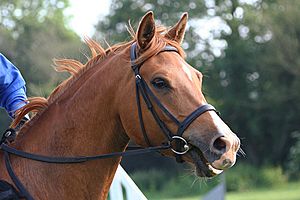Bridle facts for kids
A bridle is a special set of straps that goes on a horse's head. It helps a rider guide and control the horse. The bridle holds a bit, which is a metal piece that goes into the horse's mouth. It also has reins, which are long straps the rider holds to steer the horse.
Contents
What is a Bridle Made Of?
Most bridles are made from strong leather. They have many parts that buckle together. Each part has an important job.
Main Parts of a Bridle
- The headpiece (or crownpiece) goes over the horse's head, behind its ears.
- The browband sits across the horse's forehead.
- The throatlatch goes under the horse's chin, behind its cheek.
- The cheekpieces run down the sides of the horse's face. They connect to the bit.
- The noseband goes around the horse's nose and under its chin.
Some bridles do not have a noseband. Other nosebands are special. They help stop the horse from opening its mouth too wide. They also prevent the horse from crossing its jaw. Sometimes, a strap called a martingale attaches to the noseband. It helps keep the horse's head in a good position.
Bridles Without a Bit
Some bridles do not use a bit in the horse's mouth. These are called hackamores or bitless bridles. They control the horse using pressure. This pressure is put on the horse's nose and chin.
Bitless bridles can be good for horses. Especially if a horse has problems with its mouth. However, it can be harder to turn a horse using a bitless bridle. These bridles can also provide a lot of stopping power.
Images for kids
See also
 In Spanish: Brida (equitación) para niños
In Spanish: Brida (equitación) para niños







